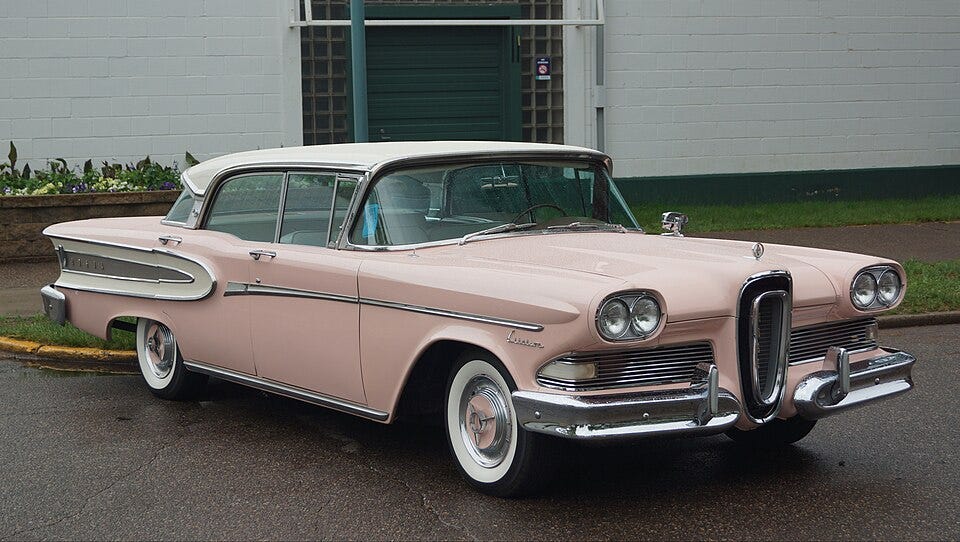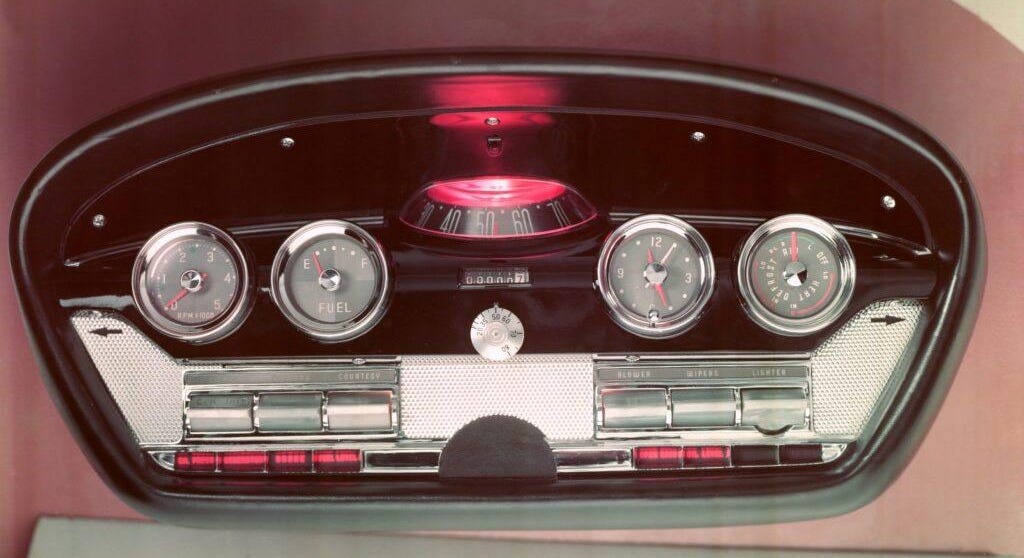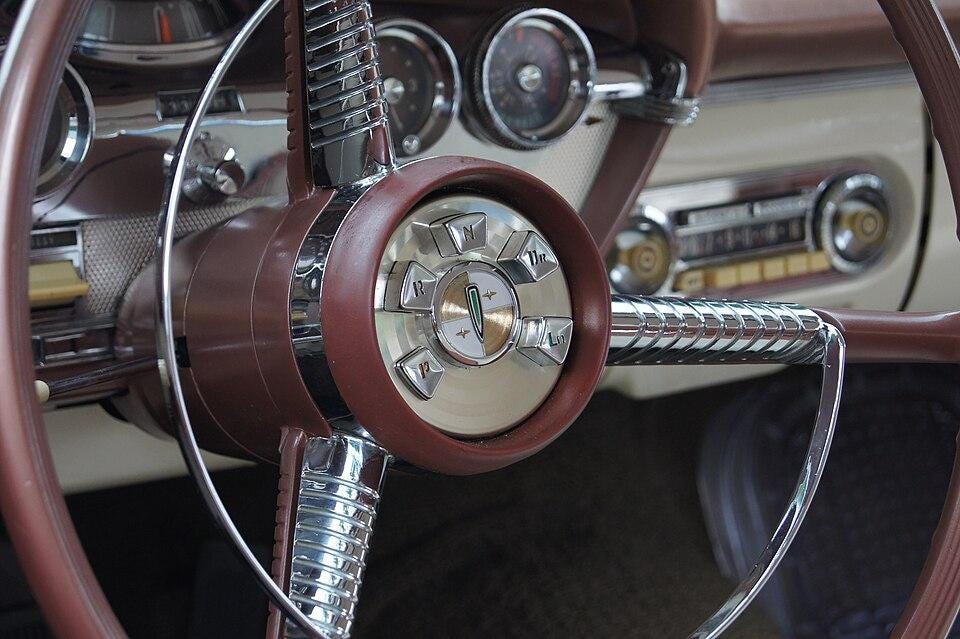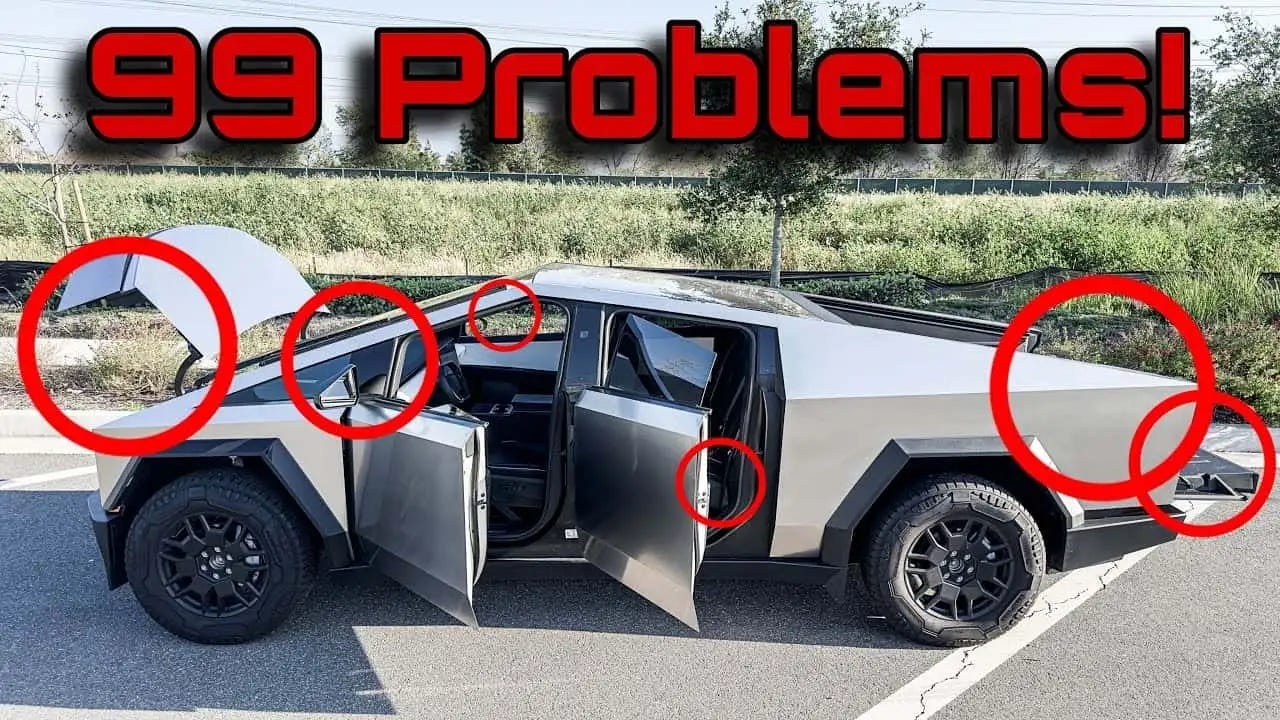Yesterday’s Car of Tomorrow
From the Edsel to the Cybertruck
Customers may want the future, but more than this, they want something that works. Seventy years ago, learning this lesson cost Ford about $2.5 billion in today's dollars. Today, Tesla is learning it with the Cybertruck. The pattern is so consistent it deserves a name.
We might call it Edsel syndrome.
On 4 September 1957, ‘E-Day’, Ford revealed the newest product in their catalogue: the Edsel. In some cases, they literally revealed it, by removing paper coverings from the vehicles themselves. The vehicles had been sent to dealers ‘under wraps’, with staff forbidden to have anyone view them until the appointed hour.
The 1958 Edsel Citation. Image courtesy of Wikimedia Commons
Ford then executed what today’s tech world would call a full-stack launch. CBS broadcast The Edsel Show live in prime time, a variety extravaganza featuring Bing Crosby, Frank Sinatra, Rosemary Clooney, Louis Armstrong, and the less-remembered-today ‘the Four Preps’. You can watch it here; if you do, you’ll join the estimated 50 million viewers that watched it on original broadcast. Other advertising followed: magazine spreads, radio ads, and more.
The Edsel was a hit, initially. Crowds gathered outside dealerships for a glimpse, while local papers reported jammed parking lots and launch-day giveaways ranging from Edsel playing-card decks to free test-drive coupons.
Nothing gold can stay. Within weeks early owners were back at dealerships, complaining of balky Teletouch shifters, mis-aligned chrome, and missing trim pieces. The mismatch between what was promised and delivered would prove fatal to the brand.
The failure of the Edsel is instructive for anyone who builds, sells, or regulates mobility tech in 2025. The Edsel was the ‘car of the future’ of its day, with the Teletouch in particular supposedly being a quantum leap forward in car interfaces. In 2025, yoke steering wheels and touch-screen controls aim to shout this is the future as loudly as the Edsel did. And that means that many of us will keep relearning the Edsel’s lesson: innovation that outruns reliability is no innovation at all.
From the 1958 Edsel Vehicle Lineup brochure, courtesy of Ford Heritage Vault
The Missing Rung
Going into the 1950s, Ford’s product ladder had a conspicuous missing rung. Then, as now, car buyers tended to be loyal to manufacturers; as their needs and circumstances changed, they switched models, but not makes. Knowing this, Ford had three offers. A thrifty buyer might start with a Ford sedan like a Fairlane; step up to a Mercury when he got a raise; and graduate to a Lincoln if he hit the big time.1
At least, that was the plan. But Ford’s own research showed that buyers weren’t cooperating. As Ford households became more prosperous, they didn’t upgrade to a Mercury; the price gap was too wide to bridge. Instead, they defected to General Motors or Chrysler. Ford’s middle was exposed.
That wasn’t a trivial problem. Post-war America was awash in upward mobility, both figurative—disposable income and access to credit was increasing—and literal: suburbanization was lengthening commutes. So vehicles were in demand, and particularly for ‘step-up’ vehicles—longer, flashier, more powerful—that could allow families to keep up with the Joneses. And that meant that Ford needed a better step-up than the Mercury was proving to be; each Ford family defecting to General Motors or Chrysler represented not only a lost sale, but also many lost future sales as brand loyalty switched (what a marketing analyst today would call lost customer lifetime value).
The internal answer, proposed in studies as early as 1948, was a new model to fill the medium-price segment. The aim was to share non-visible components with Ford and Mercury models but with distinctive external features and branding.2 The new brand would add a rung to the firm’s product ladder between Fords and Mercurys, keep Ford families loyal, and take market share from rivals. After discarding fanciful names like the Turtletop or the Pastelogram, the firm chose the name Edsel, honoring company founder Henry Ford’s only son. By 1955 the board had approved a stand-alone Edsel Division, with its own management, dealer network, and national advertising budget. Forecasts were exuberant: planners expected the medium-price slice—then roughly a third of U.S. passenger-car sales—to swell toward half the market by the mid-1960s.
Those forecasts encouraged Ford to elaborate the Edsel’s hardware to a remarkable degree. The Edsel launched with seven distinct series: the Ranger, Pacer, and Corsair (sedans); the Citation (a convertible); and the Bermuda, Villager, and Roundup (station wagons). As befitted the Next Big Thing, the Edsel had high-end touches.
Some were cosmetic and simple, like ovoid tail-lamps (not round).
Some were cosmetic and complex, like ‘rolling dome’ speedometers, which replaced the then-familiar needle-and-dial with a rotating aluminum drum, such that as the car accelerated, the drum itself turned, so the current speed spun into view.
The rolling dome; image courtesy of Maynard’s Garage
And, on the upper lines, there was the Edsel’s defining feature: the ‘Teletouch’. Instead of a column or console shift lever, premium Edsel models placed Park-Reverse-Neutral-Drive-Low buttons in a stationary pod at the center of the steering wheel. The wheel rim rotated around the fixed hub, so the driver’s thumbs always found the same buttons. Clearing the column gave stylists room for the dome speedometer and uncluttered dashboard.
The 1958 Edsel Citation Teletouch. Image courtesy of Wikimedia Commons
Why push-buttons? It was partly theatre. Detroit studios were in an arms race of visual differentiation, and Ford’s designers were well aware of the Jet Age’s love affair with push-buttons. But it was also partly a genuine exercise in ergonomics, allowing the driver to keep hands on the wheel rather than slipping over to find a lever.
On paper it was clean, modern, and safe; on paper, the Edsel’s success seemed assured.
Why It Failed
In practice, much of the Edsel’s problems were baked in from the start. Recall that for non-customer-facing parts, Ford wanted to take advantage of its existing parts and factories. Accordingly, rather than fund a dedicated plant, Ford added Edsel builds into existing Ford and Mercury assembly lines in New Jersey, Kentucky, California, and Massachusetts, on the theory that this would not only minimize capital outlays, but also let production scale with demand.
In practice, it made production chaotic and unreliable. Line workers building a run of Ford sedans would have to stop; collect Edsel-specific fascias, wiring looms, and interior pieces; complete a handful of Edsels; then switch back to building Fords. Tooling swaps and parts kitting slowed the line; under time pressure, weather-stripping was misglued, trim alignment was off-true, and some cars were passed up the line without components installed (these were tossed into the trunk for dealer installation later, which harried dealers often neglected to do). The result was that the step-up Car of the Future often looked worse on delivery than a rival firm’s cheaper Car of the Present.
At the same time, Ford’s costs failed to improve, thanks to the Edsel’s model proliferation. The model’s array of body styles and wheelbases meant a variety of specifications for trim, engines, and options. In consequence, any given variant was built infrequently, meaning that Wright’s Law could not kick in. There was too little repetition for plant crews to master Edsel-specific jobs, too many low-volume parts for the supply chain to stabilize, and too little inventory of any given option for dealers to keep a representative stock on hand.
All of this was just the opening act. The star of the show was the failure of Teletouch.
As a complex system, Teletouch was vulnerable to a host of problems. The motor it relied upon sat close to the engine, meaning it absorbed heat from the engine even as it also picked up road splash. Consequently, its insulation and contacts degraded, in warm climates because of overheating, in cold climates because of icing or road salt. Worse, because some cars arrived at dealerships with Teletouch components not yet fitted, untrained dealers and mechanics did the final install, sometimes mis-routing the wiring or failing to seal the apertures through which the wires ran. Consequently, the car could get stuck in Park, or—more dangerously—fail to downshift. And when customers sought to get this fixed, few parts were available. By the 1959 model year, Ford quietly dropped Teletouch from most Edsels and offered conventional column shifters, abandoning the brand's signature tech.
Ford had forecast roughly 200,000 first year U.S. sales and set dealer inventories accordingly. The 1958 model year fell 68% short of that forecast, closing at about 63,000 domestic units; given what Ford had spent to prepare its factories for Edsel production, and for advertising, this shortfall was disastrous. Worse, the dealer network, hastily assembled and heavily invested in Edsel-specific tooling and training, began hemorrhaging money. Many dealerships had been boostrapped, with their upfront costs paid by borrowing against projected sales volumes; when those sales failed to happen, the dealers’ debts overwhelmed them. Worse, the 1957–58 recession depressed demand for all cars just as Edsel needed momentum. The splashy launch did create a national moment for the brand, but it locked Ford into specs and schedules just as demand sagged, and customers began to want something cheap and reliable, not ‘step-up’ and notoriously dodgy.
By 1960, the Edsel Division was dissolved, its remaining models rebranded as Fords. The financial losses—estimated at $250 million in 1950s dollars, roughly $2.5 billion today—were only part of the damage. The brand's quick death meant Ford avoided the prolonged bleeding that a gradual decline might have caused, but it also amplified the stain on Ford’s reputation. Even today, Edsel is a punch line, a shorthand for spectacular failure, remembered by business-school case studies and stand-up comics alike.3
The Lessons We Still Haven’t Learned
If Edsel's demise feels like ancient history, look at the headlines around today's “software defined” or statement piece vehicles. The instinct to dramatize modernity through conspicuous controls is still with us, and so are the predictable consequences.
Consider Tesla's Cybertruck.
Elon Musk unveiled the angular pickup in 2019 to thunderous applause and immediate pre-order mania, with over 250,000 reservations in the first week, eventually swelling past two million. Like Ford's 50 million Edsel Show viewers, the initial response suggested cultural phenomenon status. The Cybertruck boasted stainless-steel body panels, a massive windshield wiper dubbed “Goliath,” and the promise of “Tank Turn” capability. All of these shouted future as loudly as Teletouch once did.
But the same gap between promise and production that killed the Edsel is killing the Cybertruck. Its steel panels require orbital sanding at the factory to eliminate visible tooling marks, erasing the possibility of scale economics. (In a similar vein, Tesla advises Cybertruck owners to use an orbital sander to maintain the vehicle’s finish, as shown in this video.) The user manual warns owners to “avoid automatic car washes”; it is strange that a vehicle touted for its ruggedness and modernity is too fragile for mechanical brushes. Early deliveries in late 2023 triggered immediate social-media compilations of panel gaps, wiper motor failures, and charging-port malfunctions. Over-the-air updates tuned its motor whine, but they can’t align crooked tailgates or stop wipers from flapping uselessly in highway wind.
Still from a video made by a frustrated Cybertruck owner, courtesy of InsideEVs.com
The Cybertruck’s collapse in sales is another echo of the Edsel debacle. Tesla projected sales of 500,000 Cybertrucks annually once production ramped, but despite boasting over a million initial reservations, the company made just 39,900 deliveries in 2024, a devastating 96% cancellation rate. By early 2025, demand had cratered further, averaging just 5,000 units per quarter, meaning that Tesla is sitting on unsold inventory worth approximately $1 billion.
It gets worse. As per Will Lockett’s look-in at the Cybertruck, Tesla's $2 billion Cybertruck investment, combined with another $3.6 billion poured into the 4680 battery cells designed primarily for the truck, consumed nearly all the company's research and development bandwidth for five years. Even assuming Tesla's claimed profitability at the company's current 2.1% operating margin, the roughly 50,000 units sold have generated perhaps $100 million in profit, meaning a 95% loss on the combined investment. Meanwhile, the 4680 cells that were supposed to revolutionize battery economics have proven slower-charging, less energy-dense, and more expensive than competitors' offerings, rendering years of exclusive development effectively obsolete. As Lockett puts it, The Cybertruck Is a Much Bigger Failure Than You Think.
Tesla's pattern repeats across the industry. GM's Chevrolet Blazer EV packed three trims, two battery sizes, and dual software stacks into its Ultium platform debut, only to trigger a stop-sale order after infotainment freezes paralyzed early deliveries. Ford's F-150 Lightning scaling from 15,000 to 150,000 planned units strained supplier quality, triggering battery-fire recalls and assembly line shutdowns. Rivian's R1T featured powered tonneau covers that failed so frequently in cold weather that the company eventually offered manual replacements. Mercedes' MBUX Hyperscreen—56 inches of curved glass spanning the entire dashboard—costs $8,000 to replace after minor accidents and has proven so glitch-prone that many owners disable it entirely.
Conversely, companies like BYD or Toyota succeed with deliberate simplicity. A few decades ago, Toyota introduced the Car of the Future of its day, the Prius, the pioneer hybrid gasoline-electric vehicle. Importantly, the only revolutionary thing about the Prius was its hybrid element; everything else was conventional. The Prius went on to be a great success. Today, BYD’s Dolphin and Atto 3 EV models dominate Asian and European markets, but offer only two drivetrain options, one interior palette, and physical controls for all critical functions. Their Blade Battery uses a single cell design across their entire range, from the $15,000 Seagull to the $150,000 Yangwang U8. These constrained options enable BYD to build three million vehicles annually while consistently delivering high quality.
Ford created the Edsel to prevent customer defection but accelerated it instead. This pitfall still exists, and manufacturers keep falling into it. They build for the customer they wish they had—early adopters with infinite patience for beta testing—rather than the customer they actually serve: someone who needs to get to work reliably in February. Until manufacturers internalize the lesson that sustainable innovation requires the discipline to say no more often than yes, they'll keep building Edsels.
It’s baffling to me that what we used to call the Big Three have abandoned this model. In the 2010s they gave up making entry-level cars in favour of expensive SUVs and crossovers… and now find that they’ve lost an entire generation of car buyers who have no brand loyalty to them.
And yes, Ford executives of this period certainly imagined their prospective buyers as “he”.
We call the latter ‘chrome’ today, metaphorically, but in this case it was literal.








Great article, and a great comparison.
I think, though, another interesting way of looking at the time since the Cybertruck’s announcement is Elon trying to depolarize electric vehicles. Everything about the Cybertruck, Tesla moving to Texas, Elon getting more spicy on Twitter, could be seen as him trying hard to appeal to red state people, culminating in his foray into the Trump-o-sphere. All of that has seemed surreal, but given the size of the bet Elon placed on the Cybertruck it makes a certain kind of sense that he would try everything to create a market for that thing, and it has all backfired profoundly.
It’s hard for me to see Tesla recovering, and sad to think we’d lose North Americas EV pioneer.
Footnote 1 feels like the subject for at least one (maybe two?!) future posts.